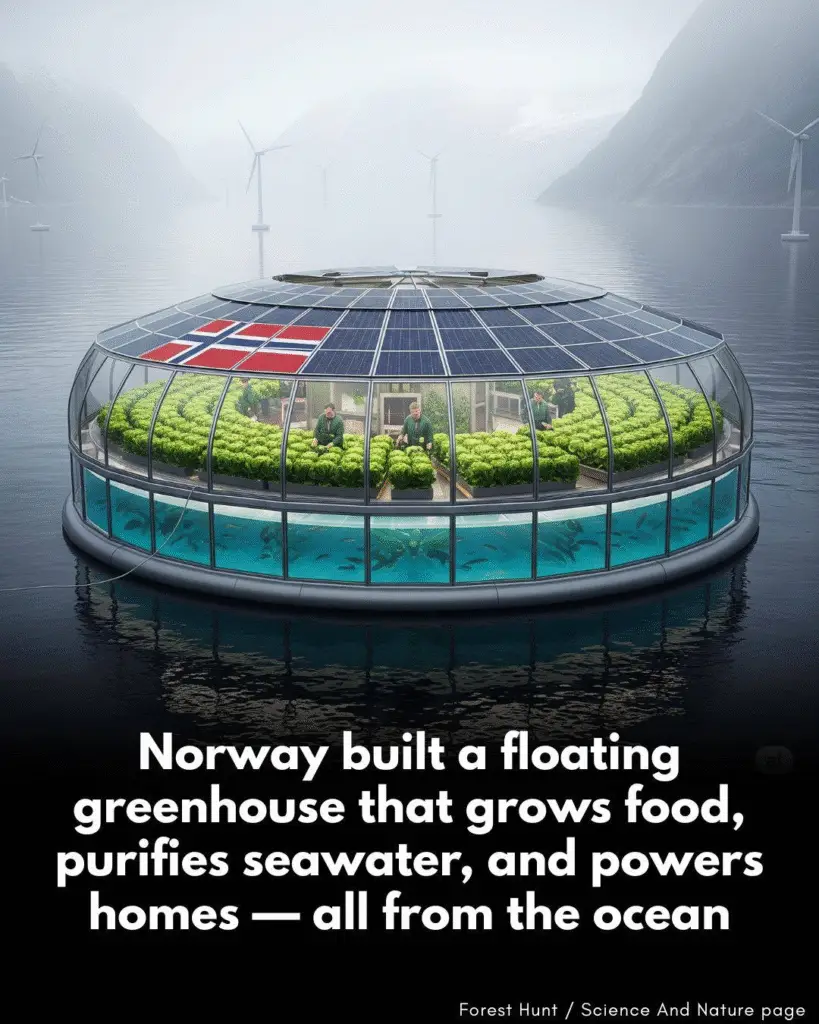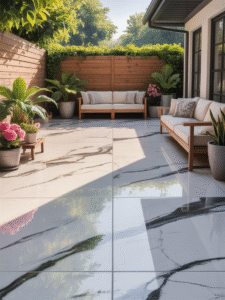Ocean Bloom: Norway’s Floating Greenhouse
Norway, a country renowned for its innovations in sustainability and ocean-based industries, has unveiled a revolutionary project that may redefine how we produce food, generate energy, and live with nature. It’s called Ocean Bloom—a floating greenhouse that grows vegetables, raises fish, and generates clean energy all in one integrated system. This futuristic platform floats gracefully on the ocean’s surface, harnessing the power of water, wind, and sun to support a self-sustaining ecosystem.

🥬 What Is Ocean Bloom?
Ocean Bloom is a large, circular floating structure anchored offshore near Norway’s coastal cities. It functions as a closed-loop ecosystem, designed to address some of the biggest challenges of our time: food insecurity, water scarcity, climate change, and energy demand. Unlike traditional farming and energy production, Ocean Bloom leaves no carbon footprint on land. Instead, it thrives on water—using ocean space to generate life and abundance.
This innovation blends hydroponic agriculture, aquaculture, and renewable energy systems into a seamless operation. Imagine a greenhouse surrounded by water, growing fresh vegetables on the surface, raising healthy fish below, and powering itself entirely through sun, wind, and waves. That’s the essence of Ocean Bloom.
🐟 How It Works
Ocean Bloom is built on a floating pontoon, which provides a stable base for multiple layers of activity:
1. Hydroponic Farming
Inside the greenhouse dome, leafy vegetables such as lettuce, kale, and herbs are grown in hydroponic beds—without soil. Instead, they receive nutrients from water enriched with fish waste. The plants thrive in this nutrient-rich water, growing faster than in conventional fields, while requiring less space and no synthetic fertilizers.
2. Aquaculture Below
Beneath the structure lies a network of enclosed fish tanks where species like salmon and tilapia are raised. As the fish grow, their waste is filtered and channeled into the hydroponic system to nourish the plants. This symbiotic relationship between plants and fish is called aquaponics—a natural, efficient cycle where nothing goes to waste.
3. Clean Energy Generation
The entire structure is powered by renewable energy sources:
- Solar panels line the top of the greenhouse dome.
- Wind turbines are installed around the perimeter.
- Wave energy converters harness the motion of the sea.
These energy sources not only run the greenhouse’s lights, pumps, and control systems—they also power a desalination unit that turns seawater into freshwater, which is then used for irrigation and fish tanks.
Any surplus electricity or clean water generated can be shared with nearby coastal communities, making Ocean Bloom more than just a farm—it becomes a mini power and water station at sea.
🌱 Environmental Benefits
Ocean Bloom is not just efficient—it’s regenerative. Its design actually improves the surrounding environment instead of harming it. Here’s how:
- Zero pollution: The system doesn’t use any synthetic fertilizers, pesticides, or antibiotics.
- No land use: Since it floats on the ocean, it doesn’t compete with farmland or forests.
- Carbon capture: A built-in algae ring helps absorb carbon dioxide from the atmosphere and ocean water, reducing ocean acidification.
- Biodiversity booster: Seaweed and shellfish can be grown on the outer edges, attracting marine life and improving local ecosystems.
⚙️ Smart Engineering & Modular Design
Ocean Bloom is designed to be modular, meaning it can be expanded or replicated. One unit can serve a small community—but dozens can be clustered to form a floating eco-village or a large-scale ocean farm. Each module includes:
- Smart sensors for monitoring plant growth, fish health, and water quality.
- Automatic climate controls to maintain optimal temperature and humidity.
- AI-powered systems for energy management and resource efficiency.
Everything is built with durability and sustainability in mind—materials are corrosion-resistant, lightweight, and designed to withstand rough marine conditions.
🌍 A Solution for the Future
As global populations grow and climate change reduces available farmland, solutions like Ocean Bloom may become essential. Coastal cities, small island nations, and even inland communities could benefit from this kind of decentralized, ocean-based food and energy production.
Imagine a world where:
- Fresh fish and vegetables are grown just offshore from major cities.
- Coastal areas become hubs of clean energy and sustainable food.
- Floating farms help restore balance to overfished seas and reduce deforestation inland.
Ocean Bloom shows us that the ocean isn’t just a resource to exploit—it can be a partner in sustainable living. By combining ancient wisdom (like using fish waste as fertilizer) with cutting-edge technology (like wave energy and smart farming), Norway has opened a door to a new kind of future—cleaner, greener, and more connected to nature.
🚀 What’s Next?
Ocean Bloom is still in its early stages, but its potential is enormous. More prototypes and pilot projects are expected to launch in coming years, not just in Norway but around the world. The concept could be adapted to different climates and needs—perhaps with rice instead of lettuce, or shellfish instead of salmon.
The ocean covers 70% of our planet. With ideas like Ocean Bloom, we’re beginning to unlock its potential—not just for survival, but for thriving in harmony with the Earth.









